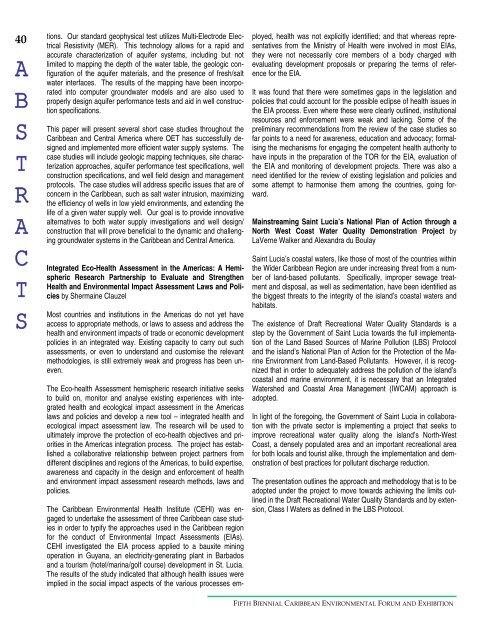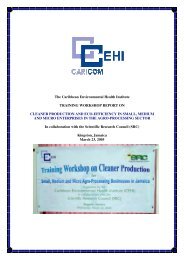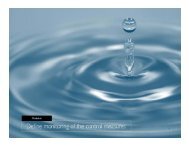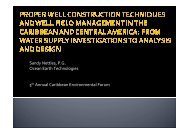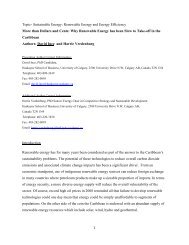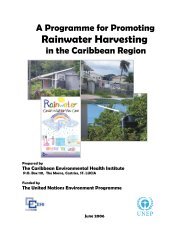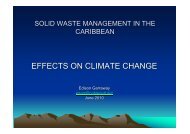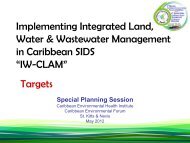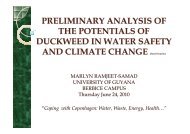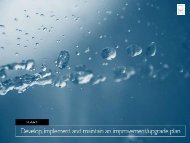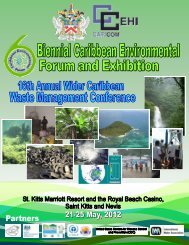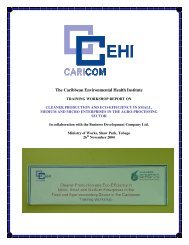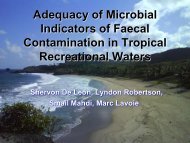conference magazine - Caribbean Environmental Health Institute
conference magazine - Caribbean Environmental Health Institute
conference magazine - Caribbean Environmental Health Institute
You also want an ePaper? Increase the reach of your titles
YUMPU automatically turns print PDFs into web optimized ePapers that Google loves.
A<br />
B<br />
S<br />
T<br />
R<br />
A<br />
C<br />
T<br />
S<br />
40<br />
tions. Our standard geophysical test utilizes Multi-Electrode Electrical<br />
Resistivity (MER). This technology allows for a rapid and<br />
accurate characterization of aquifer systems, including but not<br />
limited to mapping the depth of the water table, the geologic configuration<br />
of the aquifer materials, and the presence of fresh/salt<br />
water interfaces. The results of the mapping have been incorporated<br />
into computer groundwater models and are also used to<br />
properly design aquifer performance tests and aid in well construction<br />
specifications.<br />
This paper will present several short case studies throughout the<br />
<strong>Caribbean</strong> and Central America where OET has successfully designed<br />
and implemented more efficient water supply systems. The<br />
case studies will include geologic mapping techniques, site characterization<br />
approaches, aquifer performance test specifications, well<br />
construction specifications, and well field design and management<br />
protocols. The case studies will address specific issues that are of<br />
concern in the <strong>Caribbean</strong>, such as salt water intrusion, maximizing<br />
the efficiency of wells in low yield environments, and extending the<br />
life of a given water supply well. Our goal is to provide innovative<br />
alternatives to both water supply investigations and well design/<br />
construction that will prove beneficial to the dynamic and challenging<br />
groundwater systems in the <strong>Caribbean</strong> and Central America.<br />
Integrated Eco-<strong>Health</strong> Assessment in the Americas: A Hemispheric<br />
Research Partnership to Evaluate and Strengthen<br />
<strong>Health</strong> and <strong>Environmental</strong> Impact Assessment Laws and Policies<br />
by Shermaine Clauzel<br />
Most countries and institutions in the Americas do not yet have<br />
access to appropriate methods, or laws to assess and address the<br />
health and environment impacts of trade or economic development<br />
policies in an integrated way. Existing capacity to carry out such<br />
assessments, or even to understand and customise the relevant<br />
methodologies, is still extremely weak and progress has been uneven.<br />
The Eco-health Assessment hemispheric research initiative seeks<br />
to build on, monitor and analyse existing experiences with integrated<br />
health and ecological impact assessment in the Americas<br />
laws and policies and develop a new tool – integrated health and<br />
ecological impact assessment law. The research will be used to<br />
ultimately improve the protection of eco-health objectives and priorities<br />
in the Americas integration process. The project has established<br />
a collaborative relationship between project partners from<br />
different disciplines and regions of the Americas, to build expertise,<br />
awareness and capacity in the design and enforcement of health<br />
and environment impact assessment research methods, laws and<br />
policies.<br />
The <strong>Caribbean</strong> <strong>Environmental</strong> <strong>Health</strong> <strong>Institute</strong> (CEHI) was engaged<br />
to undertake the assessment of three <strong>Caribbean</strong> case studies<br />
in order to typify the approaches used in the <strong>Caribbean</strong> region<br />
for the conduct of <strong>Environmental</strong> Impact Assessments (EIAs).<br />
CEHI investigated the EIA process applied to a bauxite mining<br />
operation in Guyana, an electricity-generating plant in Barbados<br />
and a tourism (hotel/marina/golf course) development in St. Lucia.<br />
The results of the study indicated that although health issues were<br />
implied in the social impact aspects of the various processes employed,<br />
health was not explicitly identified; and that whereas representatives<br />
from the Ministry of <strong>Health</strong> were involved in most EIAs,<br />
they were not necessarily core members of a body charged with<br />
evaluating development proposals or preparing the terms of reference<br />
for the EIA.<br />
It was found that there were sometimes gaps in the legislation and<br />
policies that could account for the possible eclipse of health issues in<br />
the EIA process. Even where these were clearly outlined, institutional<br />
resources and enforcement were weak and lacking. Some of the<br />
preliminary recommendations from the review of the case studies so<br />
far points to a need for awareness, education and advocacy; formalising<br />
the mechanisms for engaging the competent health authority to<br />
have inputs in the preparation of the TOR for the EIA, evaluation of<br />
the EIA and monitoring of development projects. There was also a<br />
need identified for the review of existing legislation and policies and<br />
some attempt to harmonise them among the countries, going forward.<br />
Mainstreaming Saint Lucia’s National Plan of Action through a<br />
North West Coast Water Quality Demonstration Project by<br />
LaVerne Walker and Alexandra du Boulay<br />
Saint Lucia’s coastal waters, like those of most of the countries within<br />
the Wider <strong>Caribbean</strong> Region are under increasing threat from a number<br />
of land-based pollutants. Specifically, improper sewage treatment<br />
and disposal, as well as sedimentation, have been identified as<br />
the biggest threats to the integrity of the island’s coastal waters and<br />
habitats.<br />
The existence of Draft Recreational Water Quality Standards is a<br />
step by the Government of Saint Lucia towards the full implementation<br />
of the Land Based Sources of Marine Pollution (LBS) Protocol<br />
and the island’s National Plan of Action for the Protection of the Marine<br />
Environment from Land-Based Pollutants. However, it is recognized<br />
that in order to adequately address the pollution of the island’s<br />
coastal and marine environment, it is necessary that an Integrated<br />
Watershed and Coastal Area Management (IWCAM) approach is<br />
adopted.<br />
In light of the foregoing, the Government of Saint Lucia in collaboration<br />
with the private sector is implementing a project that seeks to<br />
improve recreational water quality along the island’s North-West<br />
Coast, a densely populated area and an important recreational area<br />
for both locals and tourist alike, through the implementation and demonstration<br />
of best practices for pollutant discharge reduction.<br />
The presentation outlines the approach and methodology that is to be<br />
adopted under the project to move towards achieving the limits outlined<br />
in the Draft Recreational Water Quality Standards and by extension,<br />
Class I Waters as defined in the LBS Protocol.<br />
FIFTH BIENNIAL CARIBBEAN ENVIRONMENTAL FORUM AND EXHIBITION


